Bleeding Grape Vines Pruned in Spring – Fixed! This is BIG!
By Mary G. Holland
May 11, 2015
Quickly heal bleeding grape vines pruned in spring, saving last year’s growth
I believe I have found a way to reasonably stop bleeding on spring pruned grape vines. This is BIG, especially for northern wine grape growers. It’s a way to leave as much tissue for the vine as possible to survive winter, spring prune only what winter has already killed on the grape vine, but avoid bleeding, which drains plant vigor and cuts fall yield. I’m hoping this will lead to higher fall yields – but we’ll have to wait and see.
Fall Pruning Dangers of Northern Grapes – Excessive Winter Die Back
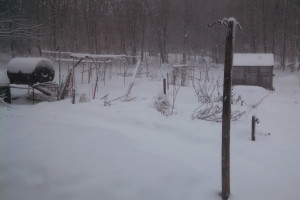
As my northern USDA Zone 3 wine grapes have started to take hold the past few years, I’ve been struggling with when is the best time to prune. The sage advice is to prune in the late fall after frost, when they go dormant. But I’ve found around here, they die far back from the pruned cut, no matter where it is. That means I’ve lost last year’s growth. Not good for yields.
Spring Pruning Dangers – Lost Vigor, Yield, Drowned Buds, Fungus
The danger of spring pruning is excessive bleeding, just when they need to get a start. Although some growers say it isn’t a problem at all, they still grow…I have found that bleeding vines don’t break bud for at least a month after those that did not bleed, and when they do finally grow, they are much weaker. Our growing season is so short (4-5 months depending on variety) that I can’t afford to lose 20-25% of it.
Other dangers of spring pruning: growers also say that if you spring prune and the vines bleed, you should expect to lose at least part, if not all, of your grape crop.
And growers say the flowing sap can drown buds lower down the vine, losing additional growth, or promote fungus infections.
The Challenge: Sidestep Winter Die Back AND Spring Pruning Dangers
I love pushing risky boundaries, and this vineyard is one of many experiments. My goal is to spring prune just what’s died or overgrown on the grape vines, and find a way to stop the inevitable bleeding, to preserve vigor and fall yield.
First Trial – 2012
I decided to experiment with a nice hardy stand of Concord grapes growing that were up to 14 years old, before getting ambitious with the wine grapes.
Late winter pruning is risky around here because we can get some really hard frosts in February, down to -20 degrees Fahrenheit. As a test, I pruned half the Concords in the fall, and the rest in late March or early April, after late heavy frosts, when everything is usually grey, muddy, and mostly frozen.
That spring as usual, the fall pruned grapes died back 3-4 nodes from the cut and were slow to take off. Many of those sent out undesirable shoots from the trunk base.
The grapes destined for spring pruning had largely self-pruned during winter to almost textbook length. I cut where I could at the winter die back length, but where they had overgrown, trimming live vines was needed. These cuts bled a little, but a dab or two of pruning sealer seemed to do the trick with the fairly gentle spring. These vines popped their buds farther up the trunk than the fall-pruned grapes. As a result, there were more viable buds and they grew much stronger. The yield was very good that fall on the spring pruned grapes.
Second Trial – 2013
I was encouraged. The next year some of my Marquette and La Crescent wine grapes grew really well (that was the year I started mulching the sandy soil with sawdust.) So I decided to wait until the next spring to prune.
All the grapes looked pretty healthy, and I pruned late March. They didn’t bleed at first, and I was out of pruning sealer anyway. Then by late April when the frost was coming out of the ground, they started to bleed. I let them go, expecting they would seal.
But they bled. And bled. And bled. They didn’t stop bleeding until late May or early June. Buds popped in June, many in late June – not good. They usually pop in May. That was a serious set-back. I pumped some organic fertilizer, compost, and water to them and they seemed to recover. They grew well but got hit like the garden by a wet summer and heavy fungus. But I got a couple of small grape clusters for the first time off the Marquettes.
Third Trial – 2014
Then last year I went out to prune in early March. It would have been a great year because the vines and buds looked really good. But unfortunately chipmunks and mice had eaten the bark off nearly all the vines, girdling most of them from ground level to 12 inches off the ground. So I cut the few partially damaged vines off to create a trunk, and sealed damaged bark with TreeKote. The girdled vines I cut completely to the ground, leaving some buds at the base. It was a sacrificial year, no choice.
Again I fed and watered, and the grapes bounced back strong, and again got a small grape cluster each on the Marquette, La Crescent, and Foch.
I decided to deal with the rodents and help protect against winter kill by wrapping the trunks last fall with 3″ landscape fabric tape to about 2 feet off the ground. I did some late fall pruning to reduce excessive growth, but still left quite a bit to ensure good winter survival.
Fourth Trial – 2015
I unwrapped the vines this spring in early April and they looked really good, no winter damage, lots of live buds and all healthy vines. Too much in fact, so live cuts were necessary.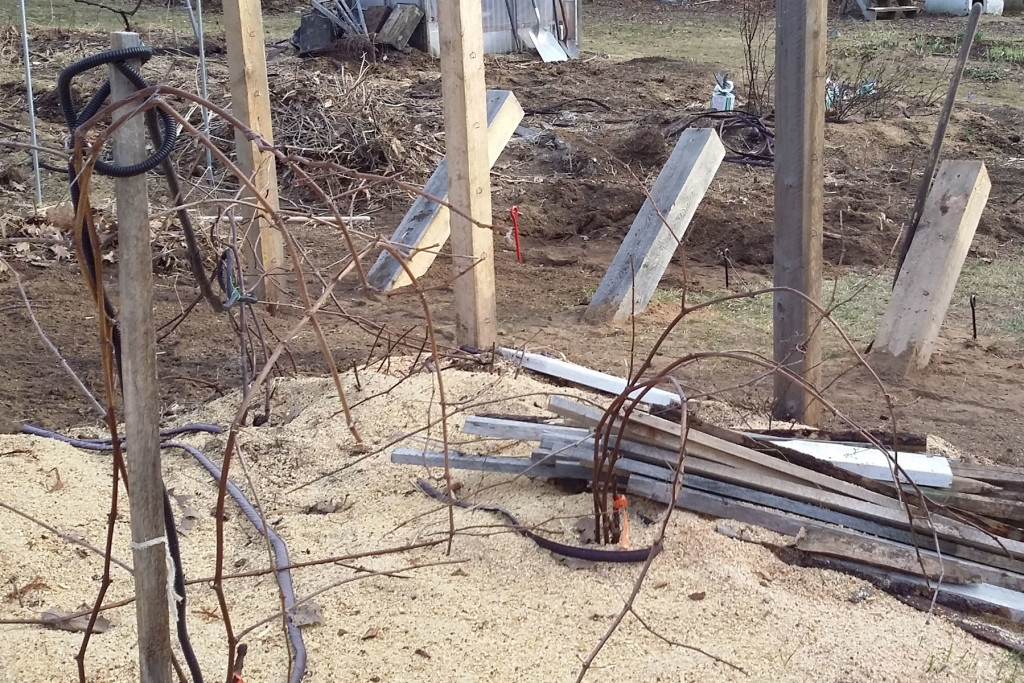
It’s typically overcast around here 90% of the time from October until sometime in April or May, and doesn’t really warm up until mid May. Suddenly in early April this year we started having sun, daytime temps reaching 50-60 degrees F, and the frost quickly left the ground. The temps were bouncing around a bit – ranging 30-60 daytime, 20-40 at night.
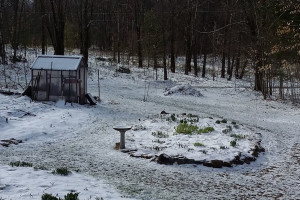
I pruned the wine grapes April 21and the Concords April 23. Then we got more cold weather and snow on April 24, just as the bulbs were starting to pop out of the ground. No bleeding, so I thought everything was fine.
Oops! Cut the Carotid!
 One week later, May 1, the temperatures shot up to 70 – 80 F. days, 40-50 F. nights. Everything started to grow all over the yard, fast, so much had to be done at once. I was frantically scrambling to get the new grape arbor in place, the remaining vines moved, spring planting done, etc. (see previous posts.)
One week later, May 1, the temperatures shot up to 70 – 80 F. days, 40-50 F. nights. Everything started to grow all over the yard, fast, so much had to be done at once. I was frantically scrambling to get the new grape arbor in place, the remaining vines moved, spring planting done, etc. (see previous posts.)
As the temperatures rose, the pruned grapes started bleeding profusely, a drip per second or two in many cases. I sealed each one heavily with pruning sealer. Most kept bleeding. I added small bandages two days later made with bits of landscaping fabric dipped in the sealer but they just made bubbles of sap, most leaked and still bled.
By May 4, it appeared some of the grapes were breaking buds, mostly those that weren’t bleeding as much. The Concords, on the other hand, were largely fine, and only had a couple minor bleeds, and were budding out gently and nicely.
HELP! What to do?
I went online and researched solutions. Here, here, here, here, here, and here are my sources. This, by the way, is also a great general quick reference on grape pruning.
Most of these sources say that it’s fine for the grapes to bleed. I don’t agree because the vines clearly lose vigor and I can’t afford the time lost nor reduced yield.
Apparently horticulturalists are migrating away from using sealer for several reasons, not the least of which is that it is petroleum based (so toxic), contrary to claims it doesn’t stop fungus or disease (and in fact frequently harbors it,) doesn’t stop bleeding very well, etc. etc.
Many said let it bleed – the sap is a natural healer. One grower also says research indicates that the sap is full of resveritol which has natural healing properties. Yes it does – this (along with zinc oxide) is an active ingredient in old-fashioned Resinol Salve, which induces very rapid healing of minor cuts, burns, insect bites.
The reference to flowing sap drowning the lower buds means not letting vines bleed.
When you cut yourself, sure, bleeding helps clean out the wound, and we also have white blood cells that go to work on germs…but when you have a fast bleeding cut, one has to stop the bleeding to move onto the next stage of wound healing. So my intuition is that the grapes will do better if bleeding is stopped quickly. My experience shows bleeding northern vines means no fall crop and possible vine loss.
These are the alternatives to pruning sealer that I gleaned. Kind of obvious when you think about basic human first aid.
1. Super glue is used in hospitals to glue wounds together instead of stitches – but as fast as some of my vines were bleeding I wasn’t sure that would work.
2. Cauterize with a hot piece of metal – but you have to be careful with the heat not to injure the vine or nearby buds. I didn’t have an efficient nor safe way to do this, given the drought and fire danger warnings presently in our region.
3. Seal with bees wax – another vine burn warning – but this might also have some cauterizing effect – still no way to keep the bees wax hot throughout treatment. Sounds like another version of a bandage. I know this works for cold winter tree grafts, but may not work any better than the pruning sealer, if done in spring when the sap pressure is up.
4. Pinch off the vine just below the cut (tourniquet) using wire or some other crimping device since the bleeding is happening just below the surface of the bark. Yup, I like this.
Solution
On May 6, 2015 I made tourniquets – with twist ties and pliers. Immediately the bleeding slowed to about half the rate or stopped, and all cuts stopped bleeding within three or four days. The second day, where they continued bleeding, I added as second tourniquet. 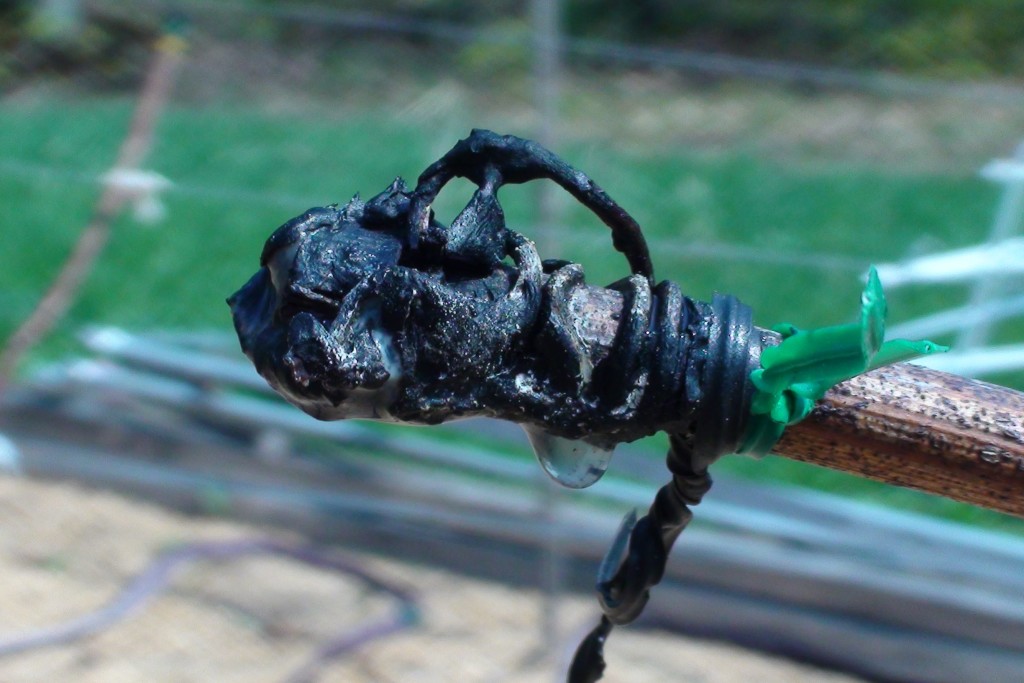 The picture here, taken day 4 of tourniquets, is of a strong La Crescent vine that had to be cut back. It was one of the heaviest bleeders. I added the green twist tie the second day. The stringy material is just some vine tendrils from last year that I didn’t bother to take off when I painted on the TreeKote. (Of course, it would have been a much cleaner job if I didn’t already have sealer all over the cuts. Instead, I collected sealer all over me as I applied first aid. Oh well.) You can see the white scab starting to form on the end. It’s also forming under the vine at the top of the thickening drip.
The picture here, taken day 4 of tourniquets, is of a strong La Crescent vine that had to be cut back. It was one of the heaviest bleeders. I added the green twist tie the second day. The stringy material is just some vine tendrils from last year that I didn’t bother to take off when I painted on the TreeKote. (Of course, it would have been a much cleaner job if I didn’t already have sealer all over the cuts. Instead, I collected sealer all over me as I applied first aid. Oh well.) You can see the white scab starting to form on the end. It’s also forming under the vine at the top of the thickening drip.
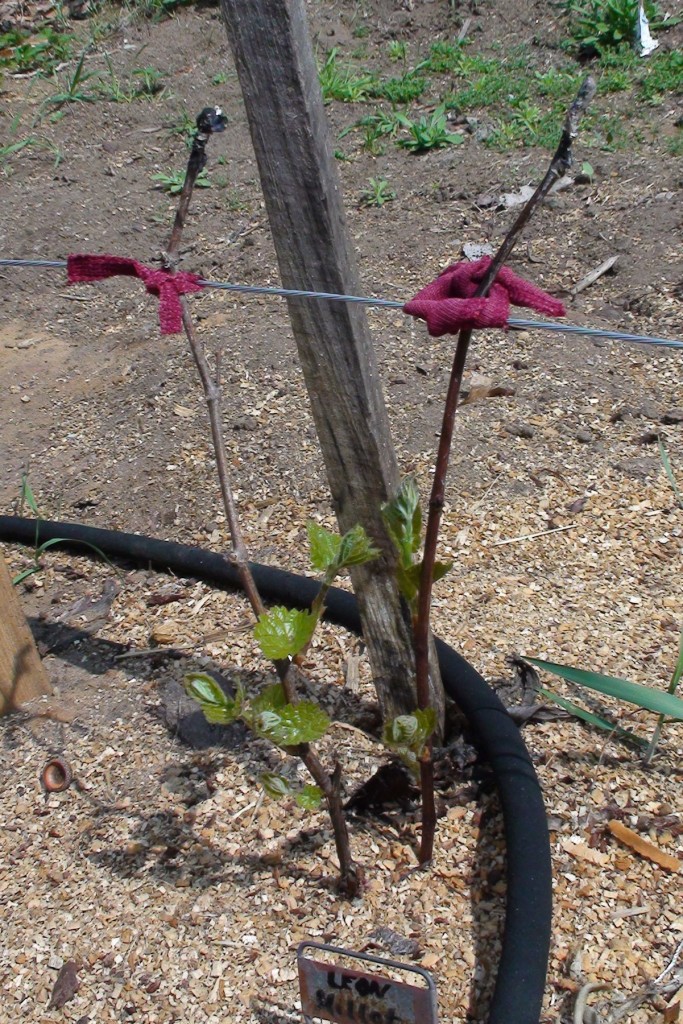 Sure enough, the buds started popping, and by day 4, every vine had started to leaf out.
Sure enough, the buds started popping, and by day 4, every vine had started to leaf out.
Conclusion
Here’s what I’ve learned so far.
Tourniquets stop a spring bleed The twist tie tourniquet works if done tightly. Temps have risen to high 80s and buds have popped with no more bleed, so I know the sap pressure is holding inside the vines.
Stronger wire next time I had some difficulty with the twist ties breaking off when using pliers. If I used my fingers, I didn’t always get it tight enough, and it was hard on the hands. If breaking continues I may try a slightly larger gauge wire, but still soft enough to wrap the vine well.
Tourniquet Technique I tried both a single wrap, and also a double wrap, then twisting. The double wrap seemed to be most effective in instantly stopping the bleed. Sometimes a second tourniquet was required the next day.
Do Some Varieties Self-Heal Better Than Others? This source shows photographic evidence of heavy December pruning on old vines healing themselves within four days or so. Clearly this is in a much warmer climate than here, so it’s a different variety. This self-sealing did not happen with mine without help – the sap remained very watery on the wine grape vines for weeks in some of my earlier tests. But because the Concords seemed to handle the pruning easily, I am beginning to think that the self-sealing compounds in the sap, and perhaps also the internal sap pressure, may be variety-specific.
Timing spring pruning We can’t predict the weather. And now during climate change, it’s even more unpredictable, swinging wildly. Extreme variations in temperature and precipitation can cause the vines to bud out quickly, or cause late frost die back. I think the only risk mitigation in northern climates is to apply a tourniquet when spring pruning.
Possible improvement I’m going for no bleeding at all. Next spring I’ll apply the wire tourniquet at least a couple weeks before pruning, likely late February through March. Then prune above the wire where the buds should have died off.
Assuming growth remains strong, and no more wacko frosts, the remaining likely risks this season are rainfall, disease, insects, animal damage. It looks like we’re in for a drought, with less than an inch of precipitation in over six weeks including the late April snow, so I’ve laid out irrigation hose. Stay tuned for future posts on progress and fall yield.
Comments and suggestions by others are most welcome.

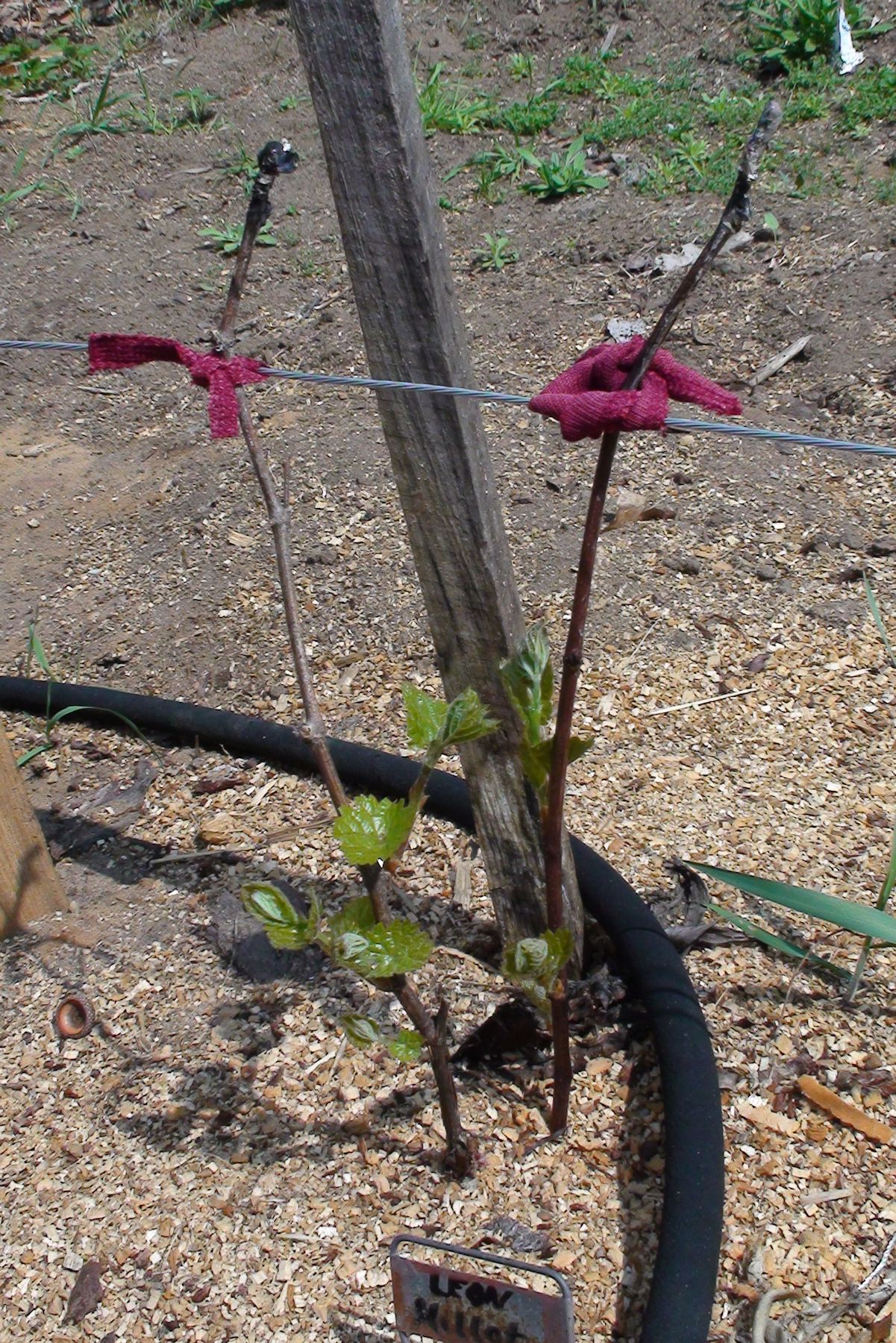
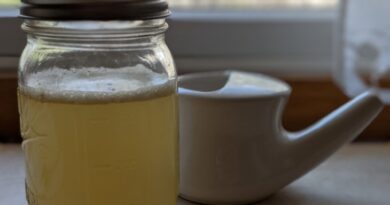
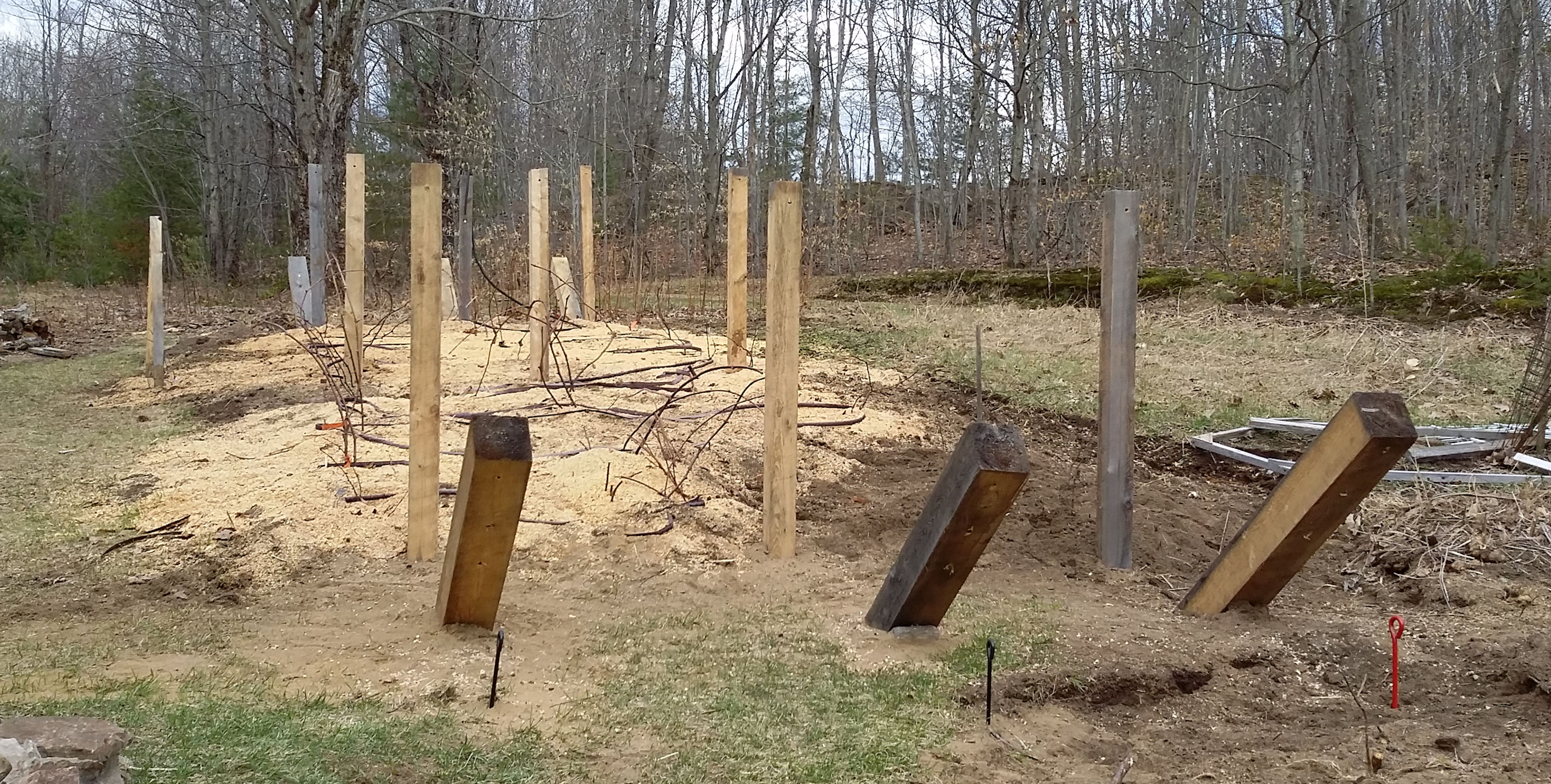
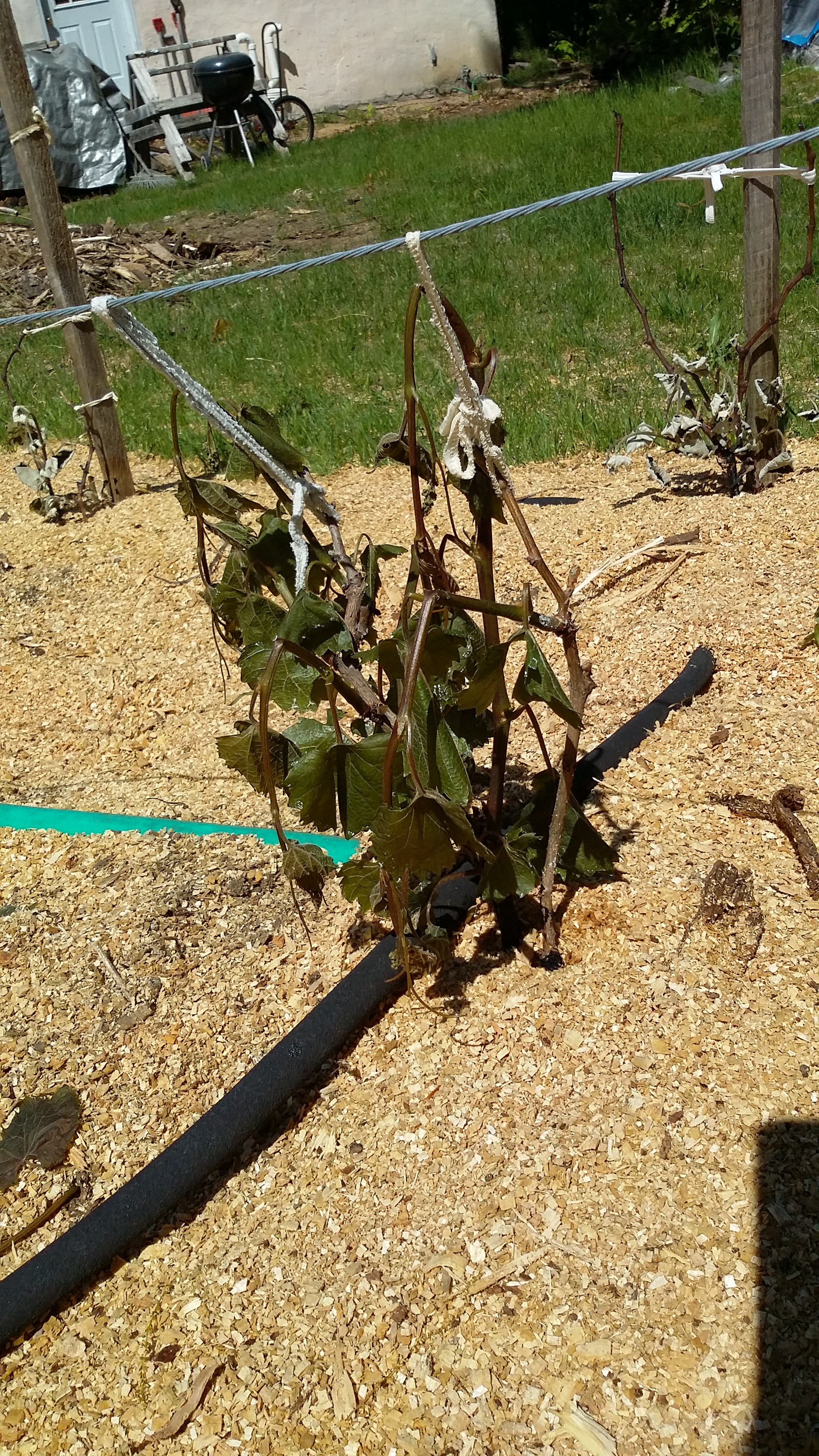
I thought I would try tourniquets after I prune my climbing hydrangea vines which have become so heavy that the rain brought the whole thing down, trellis and all. I had never heard of doing this before, so I did a Google search on “tourniquet vine” and found your site. Glad to hear of your success. I think I will give it a try and possibly use stainless steel hose clamps on some of the larger vines.
Hi Dan,
I have to say that the tourniquets were about 60% successful…I think mostly because the internal sap pressure was so high in spring when I pruned. I expect you’ll have a bit better luck with the hydrangeas. I didn’t know these bushes had problem with bleeding after pruning. I wouldn’t bother unless they do, as it takes much longer to finish the job. Next year I’m going to generally shape the vines before winter, then do the final pruning in late winter, not wait til spring. Please let us know how you fare with the hydrangeas.
Thanks for your comment and good luck!
There is something called a climbing hydrangea and it bleeds profusely and for weeks when pruned in spring, but perhaps not as much now in late spring/ early summer. I’m glad to have the tourniquet approach to fall back on.